(Fire hall #1)
140 6th Avenue S.E.

Built: 1911
Central Fire Station
(Fire hall #1)
140 6th Avenue S.E.

Built: 1911
Architect:
Lang and Major and associate architects Hodgson, Bates and Butler.
Contractor: Fyshe, Martin and Company of Calgary
Original cost: $34,021
Construction materials:
Concrete and masonry exterior, brick cladding and Calgary sandstone trim around the windows and arched bays.
Architectural style:
Classical styling. Two stories and full basement, a central pediment, a side tower with a 1300 pound brass bell and copper cupola. Fifty foot masonry bell tower is focus of the building.
Original interior details:
pressed tin ceiling, 5 brass slide poles, fir floor(2nd story) and
trim.
Alterations:
1915 - heating system converted from coal to gas. 1920 - west half
of second floor added. 1936 - two story addition to rear. 1989 - $1.1 million
renovation by Budget Rent-A-Car.
Historical highlights:
replaced Calgary's first firehall, a wooden structure at 122 7th Avenue
S.E. built in 1887 as home to the volunteer Calgary Fire Brigade.
Mayor J.W. Mitchell laid the cornerstone for the new "Fire Headquarters"
July 5, 1911 as part of the ceremonies for the Western Firemen's Association
Conference hosted by Calgary.
unique 45 degree angular placement of the building on the lot allowed
easy access to 1st Street or 6th Avenue.
the Department moved into the new building during the first week of
October 1911.
fire fighters were volunteers until 1898 when James "Cappy" Smart was
hired as the chief and first full-time paid employee of the Department.
Cappy was also the local undertaker.
By 1911 the force was full time and fully paid. In 1912 firemen were
paid $70.00 per month and lived 24 hours a day at the hall.
Fire brigade, Fire Hall No. 1, Calgary, Alberta.
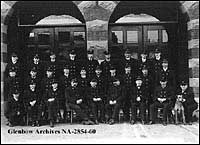
Date
Christmas 1914
Creator
Grant, A.and D. Calgary, Alberta
Remarks
Front row L-R: T. Wilkinson; William New; Tom Hughes; Neil McLaughlin;
Julian Smart; "Cappy" Smart; Maurice Markle; William Ritchie; William "Tap"
Hughes; Thomas Inch; "Slim", dog mascot. 2nd row L-R: Ernest Redshaw; James
Richardson; Henry Cowling; H. Garret; Armand Lucas; John Shearer; John
Wilson; Arthur Gibbons; Reginald Tapper. Back row L-R: Charles Burns; Arthur
Simmons; John Carey; B. Hemmings; Charles Romney; Thomas Smart; Edgar "Boston"
Dreyfus; Harold Newstead; Henry Fisher.
Chief Smart's living quarters and office were on the second floor. He
had his own brass pole from the office to the main floor but had a trap
door built around it so guests would not fall down the hole.
shortly after the hall opened, fireman Bud Fisher painted murals (landscapes)
on the walls of a small basement room. (still intact)
the western portion of the second floor was not built as specified
in the original plans but was added in 1920 to provide a gymnasium, kitchen
and lounge.
in 1945 the modern motorized fire equipment would no longer fit through
the five arched bays which easily accommodated the horse drawn vehicles
and early motorized equipment. The old swinging wooden doors (large etched
glass windows over the original doors were removed and lost) were replaced
with modern overhead doors.
during WWII the brass bell, metal dome and stone ornamentation from
the top of the hose tower was removed and replaced with an air raid siren.
Central Fire Station closed in 1973 ending 61 years of service as a
firehall.
designated a Provincial Historic Resource in 1975.
In 1989 Budget Rent-A-Car leased the building from the city and spent
$1.1 million renovating. The cupola was reconstructed in 1991.
Fire Hall No.1, Calgary, Alberta.
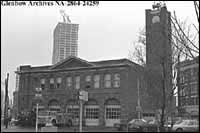
Date
December 1973
Creator
Calgary Herald, Calgary, Alberta Colville, John D., Calgary, Alberta
Remarks
Published in the Calgary Herald, December 12, 1973. Fire department
personnel and equipment were to be relocated. They will be moved to a new
facility about one block away, on the corner of 1st Street and 5th Avenue
SE.
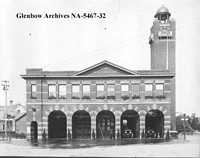
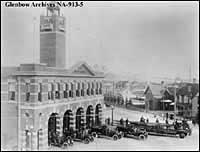
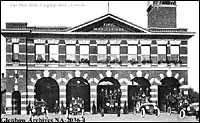
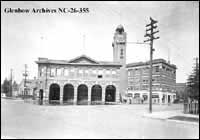
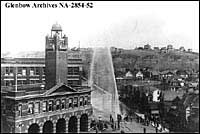
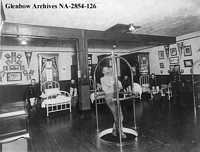
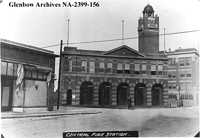
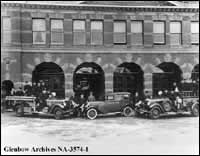
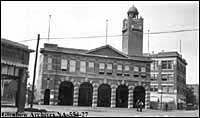
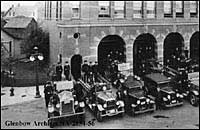
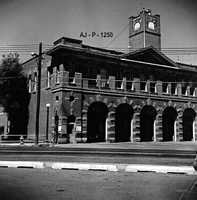
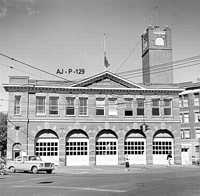
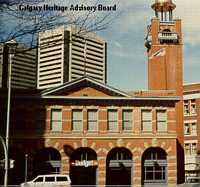
Firehall #2 (EMS Headquarters)
1801 Macleod Trail, S.W.
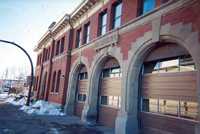
Built: 1912 -1913
Architect: Lang and Major, Calgary architects who also designed Fire Hall #1 and #3 and the city’s 1913 Police Headquarters.
Contractor: Herbert Jones and Son of Calgary
Original cost: $37,500
Construction materials: Reinforced concrete and masonry. Red pressed brick cladding and ashlar stone around the arched bays.
Architectural style: Classical styling. Two stories with ornate hose tower.
Original interior details: Pressed tin ceilings, brass slide poles, fir floors and trim.
Historical highlights:
The building permit for the city’s second firehall #2 was issued in September 1912. It was built to replace the first #2 station which had been constructed around 1904 at 119 12th Avenue S.W.
The 2nd Street S.E. station was constructed as a combined police station and firehall. Soon after the firehall opened in 1913, the staff became involved in Victoria Park Community events. During the 1913 Exhibition, #2 squad demonstrated their fire extinguishing expertise to the grandstand crowd in a public relations exercise designed to educate and entertain. Exhibition officials deliberately set fire to a two storey house with verandah which had been purchased for the display and hauled to the centre of the race track. The July 3rd Calgary Herald described the evening performance. " His worship the Mayor will discover the fire and he will at once give the alarm at a regulation signal box. The new #2 station will respond. The engines will go around the car barns and city stables, and enter the grounds on the south-side of the track. The engine carrying the hose will be driven round to the other side where the hydrant is situated. The distance traveled will be over a mile. As the doomed building has been soaked with oil and gasoline and plentifully supplied with powder the conflagration should be worth seeing. All the engines used will be motor powered and possibly one engine driven by horses will be sent in order to show the difference." A week later, #2 firemen saved the Pryce Jones store on 1st Street S.W. when a $20,000 fire broke out in the store’s kitchen.
In 1918, the police were relocated and their quarters in #2 station were taken over by the Royal Canadian Volunteer Reserve and St. John’s Ambulance.
During the 1920s a senior citizens’ group known as the Victoria Park Pioneers used the building as a meeting place.
Designated a Provincial Historic Resource on October 13, 1978.
The City of Calgary renovated the building’s interior in 1986. On December 16, 1987 the former #2 firehall re-opened as Emergency Medical Services Department headquarters.
The Paramedics and Emergency Medical Technicians of EMS provide 24 hour a day out-of-hospital emergency and non-emergency medical care and transportation at an Advanced Life Support level.
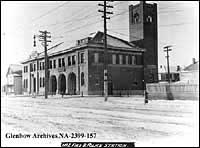
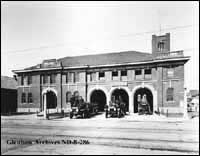
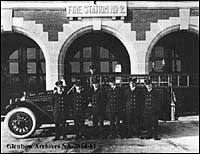
Fire Hall No. 3, Calgary, Alberta.
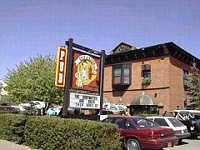
Date
2004
This warm and inviting pub occupies a turn-of-the-century firehouse
and plays out the firefighter theme throughout its open and airy interior.
The barroom ceiling is a good thirty feet above the hardwood floor; the
four other rooms all have balconies overlooking the bar, with separate
areas for dining, drinking, pool and darts. Vintage firefighting equipment
such as axes, fire-coats and ancient pumps line the walls, while a huge
ceramic Dalmatian, mascot of all firefighters, guards the bar. They serve
a full compliment of excellent burgers, steaks and other American foods.
In an old fire hall in the heart of Inglewood lies the Hose and Hound. The 'Hose' attracts an eclectic crowd with its welcoming atmosphere and top notch bar staff. The excellent selection of liquids can keep a patron busy for hours while pool tables and dart boards offer alternate entertainment, if needed. Along with respectable grub, the wings on Wednesday night are among the best in the city. If you like it spicy, ask for Jamaican jerk (three alarm) or Arsonist's Delight for some digestive punishment. If you forget your watch, no matter, the siren for last call is loud enough to wake Mr. Van Winkle from his eternal slumber.
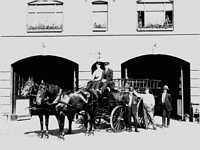
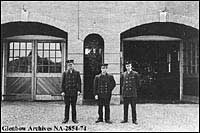
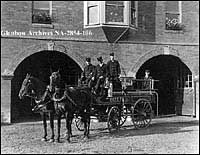
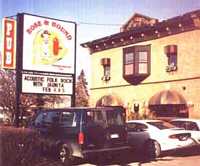
On Record Demolished Fire Halls
Fire Hall No. 5, Calgary, Alberta.
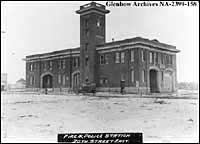
Date
1922
Remarks
Combination fire and police station. Located at 17th Avenue and 20th
Street SE, in the Mission district.
Fire Hall No. 6, Calgary, Alberta.
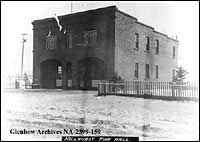
Date
1922
Remarks
Located at Hillhurst at 1111 Boulevard NW.
Fire Hall No. 7, Calgary, Alberta.
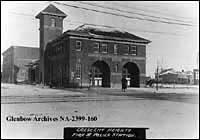
Date
1922
Remarks
Located in Crescent Heights at 140 - 16th Avenue NW. Copied from "Engineering
Report on Assets of City of Calgary", 1922.
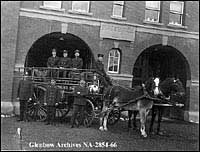
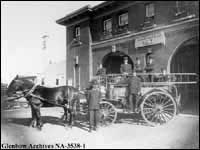
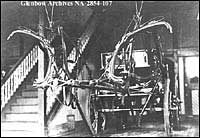
Demolition of Fire Hall No. 7, Calgary, Alberta.
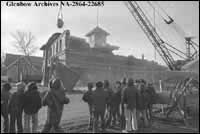
Date
March, 1973
Creator
Calgary Herald, Calgary, Alberta Herriot, Bill , Calgary, Alberta
Remarks
Published in the Calgary Herald, March 17, 1973. Fire Hall No. 7, built
in 1912, was being demolished. The building, located in Crescent Heights
at 140 - 16th Avenue NW, was also a precinct station for the police at
one time.
Fire Hall No. 8, Calgary, Alberta.
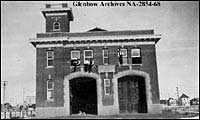
Date
1917
Remarks
Located at corner of 10th Avenue and 20th Street East. Not used as
fire station after ca. 1919.
Images courtesy of Alison Jackson & the Glenbow Archives